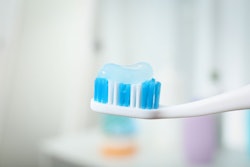Researchers at New York University have created a zinc-based compound to fight caries without the need for drilling or tooth fillings, offering an alternative to silver diamine fluoride (SDF), which can cause permanent staining.
The liquid, zinc-based compound reacts to the dentin’s pH and concentration levels, transforming into a solid that seals the tubules and gradually releases antimicrobial zinc within the tooth, according to a university news story published on September 29.
“If a compound does not stain, has good antimicrobial activity, plus it blocks the tubules, then it should be successful in stopping tooth decay and be aesthetically accepted,” Deepak Saxena, professor of molecular pathobiology and director of research innovation and entrepreneurship at the university, said in the story.
Zinc has long been used in dentistry for its antimicrobial properties, as an ingredient in toothpaste and mouthwash. One common form, zinc phosphate, has been safely used as a dental adhesive and is already approved in other applications. Therefore, zinc phosphate may help accelerate research into new caries treatment compared to untested materials, according to the story.
The researchers began investigating zinc phosphate to explore how it interacts with caries and whether it can penetrate deeply into teeth. For the treatment to relieve pain and hypersensitivity, it must reach the dentin. Each square millimeter of dentin contains around 40,000 tiny hollow tubules that can transmit sensation.
The team applied phosphate and then zinc to thin slices of human teeth and observed deposits of the compound deep within these tubules. Although the zinc phosphate effectively permeated the dentin, applying two separate treatments was not practical for clinical use. To simplify the process, the researchers developed a new molecule called zinc tetramine difluoride, according to the story.
This compound starts as a liquid that reacts to pH and concentration changes within the tooth, transforming into a solid zinc oxide once absorbed. The solid then seals the tubules and slowly releases antimicrobial zinc to protect the tooth.
In further tests, zinc oxide deposits remained in the dentin for at least one to two months. The researchers’ goal is to create a treatment that can stay active longer, reducing hypersensitivity and preventing bacterial growth, according to the story.
“We know that there's a need -- and a market -- for a product that stops tooth decay that is effective, cheap, easy to use, and non-staining, given the rise in global numbers of untreated cavities,” Saxena said.




















